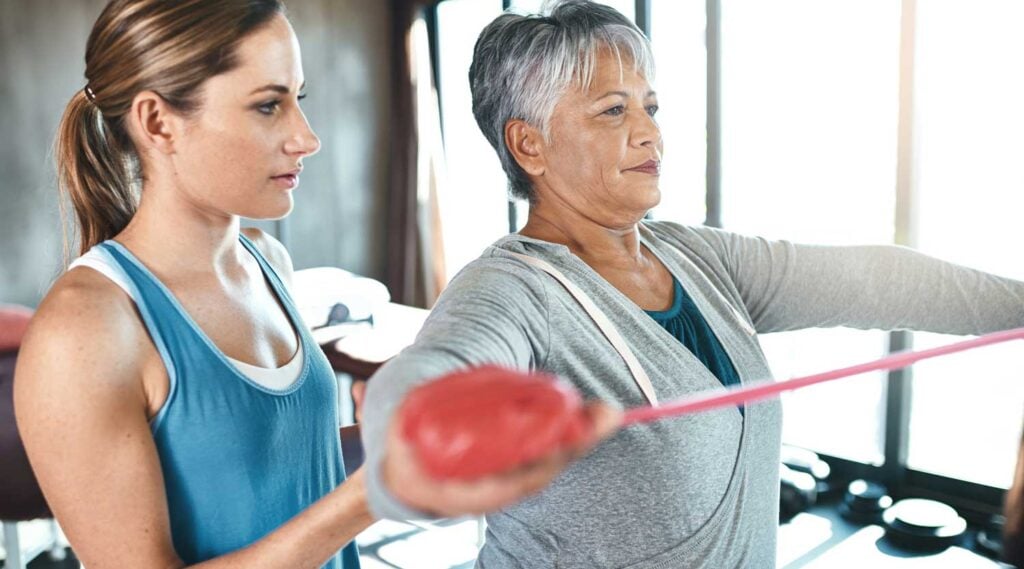Menopause Relief: Preventing Bone Loss

What is osteoporosis?
Osteoporosis, also known as brittle bones, is deterioration of bone tissue that leads to bone fragility and increased risk of fracture.
To understand how osteoporosis develops, it’s important to understand how our bones work. Constantly, our bones are being remodeled. This is a natural, healthy cycle in which calcium is taken out of the bone and absorbed back into the blood (resorption), followed by deposit of new bone. This turnover helps repair any minor damage that may occur with wear and tear.
In our growth years, up until about age 25, calcium is deposited into the bone faster than it is taken out. In the bone, it forms thick, dense white webs of calcium crystals – that’s what hardens our bones.
Menopause
But at menopause (and for many men age 60 and older), calcium deposits slow down. The bones are not getting the calcium they need. Small holes, like broken spider webs, begin to appear in the calcium crystals holding the bones together. As more calcium is pulled out, these holes grow and grow until bones begin to crumble. A simple fall shatters a hip. Even a cough, as harmless as it seems, can break a rib.
How do I know if I have osteoporosis?
Early on, osteoporosis is often a silent disease. But early detection is important because prevention strategies can stave off bone loss.
A quick, pain-free exam called DEXA bone density testing, now used by the physicians at the Pritikin Longevity Center, is the most advanced technology for accurately assessing osteoporosis risk. Standard x-rays do not detect osteoporosis until one-quarter of bone mass is already lost. By then, susceptibility to fracture already exists. DEXA detects as little as one percent of bone loss.
After a diagnosis is made, routine follow-up with DEXA should be performed at least annually to monitor bone health.
How do I prevent bone loss?
Physical activity
Several exercise trials using strength training and weight-bearing aerobic activities like walking have reported significant positive effects on bone mineral density. Increases averaged 1 to 3% and were achieved yearly thereafter.
In addition to building bone, regular exercise, especially strength training, builds muscle strength, which can help protect older people against falls. More than 90% of hip fractures are the immediate consequence of a fall.
The optimal diet
To keep bones strong, the solution is much more complex than taking calcium supplements. In fact, physicians and dietitians at Pritikin have often said that the osteoporosis problem in America is probably not solely a result of our under consumption of calcium; it is more than likely due to several factors, including our over consumption of salt, animal protein, soft drinks, caffeine, refined carbohydrates, vitamin A (retinal) from animal foods, and alcohol, as well as smoking, all of which leach calcium and other important nutrients out of the bone or decrease calcium absorption.
Conversely, the Pritikin Program is a rich source of virtually all the nutrients – magnesium, boron, zinc, copper, vitamin D, vitamin K, as well as calcium – that help keep bones strong. Dairy is important but so are fruits and vegetables, especially leafy greens. In fact, collard greens have as much calcium per cup as milk. And many foods that are high in calcium are also high in magnesium, a nutrient that is essential for several biochemical reactions that build bone. Good sources of magnesium are vegetables, whole grains, legumes, nuts and seeds – all part of the Pritikin Program.
Bone-Building Stars
Excellent dietary sources of calcium (and many other bone-building nutrients like magnesium, zinc, and boron) include:
| Green Leafy Vegetables (cooked, per cup) | Calcium (mg) |
|---|---|
| Collard greens | 300 |
| Turnip greens | 229 |
| Bok choy | 200 |
| Kale | 179 |
| Mustard greens | 150 |
| Broccoli | 150 |
| Artichoke (1 large) | 102 |
| Parsley (dried, ¼ cup) | 72 |
| Fish | Calcium (mg) |
|---|---|
| Sardines (with bones, 3 ½ oz can) | 300 |
| Oysters (raw, 1 cup) | 226 |
| Salmon (canned with bones, 3 oz) | 199 |

Learn More About Pritikin
| Beans and Legumes | Calcium (mg) |
|---|---|
| Tempeh | 172 |
| Garbanzo beans | 150 |
| Tofu – firm | 150 |
| Black beans (1 cup, cooked) | 135 |
| Pinto beans (1 cup, cooked) | 128 |
| Dairy | Calcium (mg) |
|---|---|
| Ricotta cheese, nonfat (1/2 cup) | 337 |
| Milk (nonfat, 1 cup) | 300 |
| Yogurt (nonfat, 1 cup) | 300 |
| Mineral Waters | Calcium (mg) |
|---|---|
| San Pellegrino (1 liter) | 200 |
| Perrier (1 liter) | 140 |
| Other Sources | Calcium (mg) |
|---|---|
| Sesame seeds (1/4 cup) | 352 |
| Orange juice (calcium fortified, 1 cup) | 350 |
| Seaweed (1 oz) | 350 |
| Soy milk (calcium fortified, 1 cup) | 300 |
| Almonds (1/4 cup) | 150 |
| Blackstrap molasses (1 tablespoon) | 137 |
| Corn tortillas (two) | 120 |
Calcium Supplementation
The RDA’s for calcium in the U.S. are high because osteoporosis in this country is now epidemic. One out of every three postmenopausal U.S. women suffers from weak bones. Public health leaders are struggling to stave off bone loss, and one way to do it, they believe, is with calcium supplements.
Most of the world’s population, however, gets its calcium and other bone-building nutrients from foods, particularly plant sources. The China Study conducted by scientists at Cornell University in the 1990s, one of the largest epidemiological studies on diet and disease risk ever done, found that people in rural China consumed only half the calcium of Americans, yet suffered only one-fifth the hip fracture rate of U.S. women. In Africa, Bantu women take in a mere 150 to 400 mg of dietary calcium daily, yet osteoporosis is virtually unknown. But when relatives of these same Bantu people migrate to more affluent societies with fattier, saltier, meat-based diets, osteoporosis and diseases of the teeth soar.
If you want to hedge your bets with calcium supplementation, by all means do so, especially if you already have osteoporosis, or if you’re trying to do everything you can to build bone back. Currently, the RDA is 1,300mg of calcium for adolescents; 1,000 for young adults; 1,200 if you’re past menopause and taking hormone replacement therapy (which tends to increase bone density); and 1,500 if you’re postmenopausaland not on hormones. Pritikin Program recommendations are the same.
Reviewing the list of foods in the chart “Bone Building Stars” may help you determine the approximate amount of calcium you’re deriving from your diet. Following the Pritikin Eating Plan – and making sure to include two servings of dairy or calcium-fortified products like soy milk every day – means you’re probably tallying up more than 1,000mg of calcium daily. Subtract your dietary estimate from the RDA recommendation for your specific age and condition to determine how much more calcium (if any) you need from either diet or supplements.
If, for example, you’re postmenopausal and not on hormones, and you determine you’re currently taking in about 1,200mg of calcium daily, you’d only need 300mg more to achieve the RDA.
The recommended form of calcium supplementation is calcium citrate because it’s absorbed even if you don’t have a lot of acid in your stomach, a deficiency that is common as people get older. Calcium carbonate, the type of calcium found in Tums, is not readily absorbed in those with acid deficiency. If you take Tums, take it with food. Calcium citrate works with or without food.
Vitamin D
Vitamin D is vital for strong bones. It helps absorb calcium into the bone. Fortified milk and soy milk are excellent sources, as is the sun. If you’re outdoors without sunscreen for 15 minutes two to three times a week, you’re probably getting enough sunlight. And for most individuals, 15 minutes is not enough to burn skin.
But if you live in the northern states, you may not get enough sun in late fall and winter. Several studies on elderly women in Maine and Massachusettsfound that during the winter months, Vitamin D levels in the blood drop, sometimes to very low levels, and at the same time bone density decreases.
If you are not consuming D-fortified foods and not getting enough sunlight,chances are you would benefit from a daily Vitamin D supplement. Takeat least 1,000 IU of Vitamin D daily; up to 2,000 IU appear safe fornearly everyone.
Medications
Medications currently prescribed to prevent bone loss include estrogen,bisphosphonates, calcitonin, and selective estrogen receptor modulators.To assess benefits as well as risks of these various medication for yourspecific health profile, consult with your physician.
